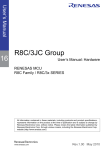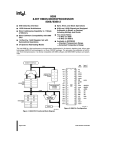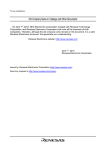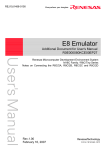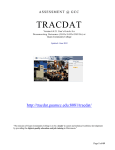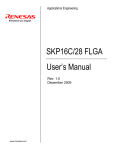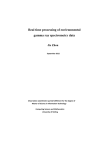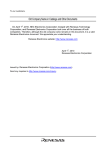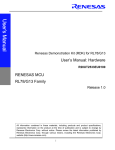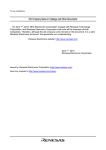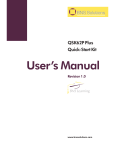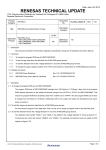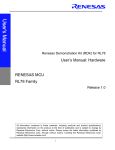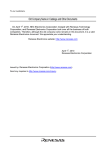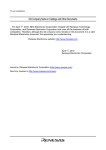Download Neutrino User Manual
Transcript
. Powerful Processors – Easy to Use™ YR8CSPB Subatomic Particle Board User’s Manual Rev. 1.1 June 2008 www.renesas.com Table of Contents 1.0 Preface ................................................................................................................................................... 3 1.1. Cautions............................................................................................................................................. 3 1.2. Trademarks........................................................................................................................................ 3 1.3. Copyright ........................................................................................................................................... 3 2.0 Introduction ............................................................................................................................................. 3 3.0 Contents of Product Package................................................................................................................. 4 3.1. YR8CSPB Quick Start Kit Item List ................................................................................................... 4 3.1.1. DVD-ROM ................................................................................................................................... 4 4.0 Limited Guarantee and Support ............................................................................................................. 5 5.0 System Connectivity ............................................................................................................................... 6 5.1. Host Computer Requirements ........................................................................................................... 7 5.2. YR8CSPB Board ............................................................................................................................... 7 5.3. Software Development Tools ............................................................................................................ 7 5.3.1. HEW (High-performance Embedded Workshop)........................................................................ 7 5.3.2. NC30WA Evaluation Version C Compiler ................................................................................... 7 5.3.3. HEW Debug Interface ................................................................................................................. 7 5.3.4. Flash Development Toolkit.......................................................................................................... 7 6.0 Hardware ................................................................................................................................................ 8 6.1. YR8CSPB Board ............................................................................................................................... 8 6.2. YR8CSPB Board Block Diagram....................................................................................................... 9 6.3. R8C/25 Group of MCUs .................................................................................................................... 9 7.0 System Operation & Limitations ........................................................................................................... 10 7.1. Kernel (ROM Monitor) Introduction.................................................................................................. 10 7.2. Pin and Peripheral Limitations......................................................................................................... 11 7.3. Memory Map.................................................................................................................................... 11 7.4. Register Operation Limitations ........................................................................................................ 12 7.5. Limitations on Interrupts – Vectors that Reside in the Hardware Vector Table .............................. 12 7.6. Stop or Wait Mode Limitations......................................................................................................... 12 7.7. User Program’s Real-Time Capability (Very Important – Please Read) ......................................... 12 7.8. Performing Debug Using Symbols .................................................................................................. 13 8.0 YR8CSPB Board Specifications ........................................................................................................... 14 8.1. Hardware Specifications.................................................................................................................. 14 8.2. YR8CSPB Status LED..................................................................................................................... 14 8.3. Power Supply Requirements ........................................................................................................... 14 8.4. Power-Up Behavior.......................................................................................................................... 14 8.5. Operating Environment.................................................................................................................... 15 Appendix A. Expansion Headers................................................................................................................ 16 Appendix B. Board Schematic & BOM ....................................................................................................... 17 Appendix C. YR8CSPB Printed Circuit Board............................................................................................ 20 YR8CSPB SBP V0.1 December 2007 1.0 Preface 1.1. Cautions This document may, wholly or partially, be subject to change without notice. All rights reserved. No one is permitted to reproduce or duplicate, in any form, a part of or this entire document without the written permission of Renesas Technology Corporation. 1.2. Trademarks All brand or product names used in this manual are trademarks or registered trademarks of their respective companies or organizations. 1.3. Copyright © Renesas Technology Corporation. 2007. All rights reserved. Website: http://www.renesas.com 2.0 Introduction The Renesas YR8CSPB Subatomic Particle Board (SPB) is a low-cost development environment for evaluating R8C/Tiny series microcontrollers (MCU) and Renesas software development tools. The included interactive Flash Video Tutorials teach you how to install and use the Renesas software development tools. The kit comes with a complete software development tool chain for Renesas MCUs, including Highperformance Embedded Workshop (HEW), which consists of Integrated Development Environment (IDE), Graphical User Interface (GUI) and Software Debugger; NC30WA C-compiler, assembler and linker; and Flash Development Toolkit (FDT) programming software. The YR8CSPB board features on-board in-circuit debugging and programming support, eliminating the need for an external In-Circuit Debug (ICD) unit. All that is required for in-circuit debugging and programming with the YR8CSPB is a USB connection to a PC and the included development tool software. A real-time, source-level debug environment is implemented using the HEW software debug interface in conjunction with the YR8CSPB board. The Flash Development Toolkit Programmer software allows insystem programming of the YR8CSPB board’s R5F21258SNFP Flash MCU. The YR8CSPB board features an R8C/25 group MCU, switch, LEDs, photo sensor, serial external Flash and audio amplifier circuit for user experiments. Example application code and peripheral device initialization code are provided on DVD-ROM. This manual provides the technical details of the YR8CSPB hardware. The Quick Start Guide and Flash Video tutorials provide details on the software installation and usage of the debugging environment. YR8CSPB SBP V1.1 3/ 20 June 2008 3.0 Contents of Product Package This section describes the contents of the YR8CSPB product package. When unpacking your YR8CSPB Kit, please check to see that all items listed below are included. 3.1. YR8CSPB Quick Start Kit Item List Table 3-1 lists the items included in the YR8CSPB. Table 3-1 YR8CSPB Item List Item Name YR8CSPB Board 3′ Mini USB Cable Stereo Headphones DVD-ROM Quantity 1 1 1 1 Remarks R8C/Tiny SPB with integrated in-circuit debugging and programming support Connects YR8CSPB board to Host PC Connects to YR8CSPB board headphone jack Auto-install program HEW (IDE & debugger) NC30WA (C-compiler, assembler, and linker) Flash Development Toolkit Programming Software USB drivers Manuals Tutorials Sample programs Renesas WOW Installer and Player 3.1.1. DVD-ROM The DVD-ROM contains the electronic manuals and software necessary for developing programs. Your computer must have a web browser — like Mozilla Firefox, Netscape® Browser or Microsoft® Internet Explorer — to view the help files, and Adobe® Acrobat® Reader® to view the manuals. Insert the enclosed DVD into your computer and the installer should auto-start. The installer program will create C:\Renesas and C:\Workspace folders on your machine. NC30WA, Documentation and sample code are installed in the C:\Renesas folder. HEW and Flash Development Toolkit programming software are installed in the C:\Program Files\Renesas folder by default. If the installer program does not start, browse to the DVD’s root folder and double-click on SPB-installer.exe to start the installation. See the QuickStart Guide for more details. YR8CSPB SBP V1.1 4/ 20 June 2008 4.0 Limited Guarantee and Support Renesas Technology America, Inc., warrants the YR8CSPB to be free from component or assembly defects for a period of 180 days from the date of purchase. Settlement is limited to repair or replacement of the product only. Renesas Technology America, Inc., does not assume any liability arising out of the application or use of any product, circuit or procedure described herein. No other liability or warranty applies, expressed or implied. Software warranty is limited to replacement of the DVD only. While every attempt has been made to ensure accurate documentation, Renesas Technology America, Inc., cannot be held responsible for errors or omissions, and reserves the right to make changes without prior notice. Support for the YR8CSPB kit is provided via the following channels: 1. Renesas website: http://www.america.renesas.com/spb 2. Online User Forums , FAQs, technical papers, downloads and more at http://renesasrulz.com 3. Renesas Technical Support Center, email at [email protected] General information on Renesas Microcontrollers can be found at the following URL: http://www.renesas.com YR8CSPB SBP V1.1 5/ 20 June 2008 5.0 System Connectivity The following lists the hardware and software products required for using the YR8CSPB Quick Start Kit. • • • • • Host Computer (supplied by user) YR8CSPB Board Mini USB cable Software Tools (HEW IDE, NC30 Compiler/Linker, Flash Development Toolkit Programmer) Optional Hardware: Supplied Stereo Headphones or amplified speaker(s). Figure 5-1: YR8CSPB System Connectivity YR8CSPB SBP V1.1 6/ 20 June 2008 5.1. Host Computer Requirements The minimum requirement to be able to use the software that comes with the YR8CSPB is a PC with a USB port and Microsoft Windows XP or Vista. 5.2. YR8CSPB Board The YR8CSPB board provides an evaluation and development environment for the R8C/Tiny series MCUs. See section “6.0 Hardware” for more details. 5.3. Software Development Tools The installer program installs all the development tools. For details on installation, see the QuickStart Guide. A brief description of all the included tools follows. Please refer to the individual tool manuals for detailed information. 5.3.1. HEW (High-performance Embedded Workshop) HEW provides a Graphical User Interface (GUI) that integrates the software development tools and includes the C-compiler, assembler, linker, debugger and editor. 5.3.2. NC30WA Evaluation Version C Compiler The evaluation version of the NC30WA C-compiler is provided with the same functionality as the commercial version except that link size will be restricted to 64 Kbytes after 60 days from when you begin using the compiler. Contact your local sales representative if you wish to purchase a full license. 5.3.3. HEW Debug Interface HEW communicates with a kernel (i.e. a ROM monitor program) on the target MCU through the ICD. This debug interface provides a highly efficient evaluation environment. Features include: • • • • • Source-level debugging for assembly and C language Single-step command (unlimited breakpoints) Run command with 2 breakpoints* for the R8C/25 RAM monitor function C variable “watch” window *Note: The number of breakpoints will vary depending on the R8C/Tiny Flash MCU used. 5.3.4. Flash Development Toolkit The Flash Development Toolkit Programmer application provides In-System Programming capability for the starter kit or any target board using an M16C family Flash MCU (e.g. R8C, M16C, M32C). Please see the Flash Development Toolkit User Guide for more details. YR8CSPB SBP V1.1 7/ 20 June 2008 6.0 Hardware 6.1. YR8CSPB Board Figure 6-1 shows the YR8CSPB Board with major components identified. Figure 6-1: YR8CSPB Board YR8CSPB SBP V1.1 8/ 20 June 2008 6.2. YR8CSPB Board Block Diagram The YR8CSPB board incorporates an R5F21258SNFP (52-pin QFP) from the R8C/25 group of microcontrollers, designated as U6. Figure 6-2 shows the YR8CSPB block diagram. Figure 6-2: YR8CSPB Block Diagram 6.3. R8C/25 Group of MCUs The R8C/25 group of 16-bit single-chip Flash microcontrollers (MCU) is part of the M16C family and utilizes an R8C/Tiny series CPU core. The hardware and software manuals for the R8C/25 group of microcontrollers can be found in the C:\Renesas\YR8CSPB\Docs folder on your PC or from the Start menu (Start > Programs > Renesas > YR8CSPB > Document Descriptions) after SPB software installation. YR8CSPB SBP V1.1 9/ 20 June 2008 7.0 System Operation & Limitations The YR8CSPB board provides sophisticated debugging features at a low cost via its on-board in-circuit debugging and programming circuitry (ICD). For R8C/Tiny boards without on-board debugging/programming circuitry, Renesas offers the functionally equivalent, standalone E8 in-circuit debugger/programmer. You can find detailed information on the E8 and its functionality in the E8 Emulator User’s Manual, which you can view via the HEW Manual Navigator. The YR8CSPB board does have some limitations when used with the HEW software debugger and the board’s ICD circuit. Section 7.1 introduces the kernel (ROM monitor) program and its purpose. The limitations when this kernel is running with the user program are listed in Table 7-1. Table 7-1: System Limitations when Debugging Item Please Refer To 7.2 Pin and Peripheral Limitations 7.3 Memory Map User Limitations 7.4 Register Operation Limitations 7.5 Limitations on Interrupts – Vectors that Reside in the Hardware Vector Table 7.6 Stop or Wait Mode Limitations The kernel cannot be run in STOP or WAIT modes. Do not use these Debugger Limitations modes when debugging your program 7.7 User Program’s Real-Time Capability 7.1. Kernel (ROM Monitor) Introduction During debug, a small program called a kernel is uploaded to the R8C/25 (R5F21258SNFP) MCU. The kernel communicates with HEW through the ICD portion of the YR8CSPB board regarding MCU status during user code debugging operations. There are no special steps required in the user program to make use of the ICD portion. The operation of the kernel is transparent to the user, but there are some limitations. These are discussed from section 7.2 onward. After starting a HEW debug session, the ICD uploads the kernel to the R8C/25 if it does not already exist (e.g. on a blank device or a device that was programmed with the Flash Development Toolkit Programmer). After downloading the kernel, the R8C/25 is ready to download user code. Connecting the YR8CSPB board without starting HEW will not affect the signal lines connected between the ICD MCU (HD64F2215RUBR) and the R8C/25; the ICD MCU keeps the signal lines in highimpedance state. The ICD MCU only drives the pins after HEW or the Flash Development Toolkit software attempts to connect. After completing program debug and verification with HEW, you can create an image of your code in Intel (.hex) or Motorola (.mot) file formats. This image can be programmed into the R8C/25 using the Flash Development Toolkit programming software. This procedure erases the kernel and leaves only the user program. YR8CSPB SBP V1.1 10/ 20 June 2008 7.2. Pin and Peripheral Limitations The Mode and Reset pins are used for communication between the R8C/25 kernel on the YR8CSPB board and the board’s ICD MCU (HD64F2215RUBR). Do not connect these pins to any other circuit, as they cannot be used in the user program while using the Debugger. The E8 debugger uses up to 8 bytes of the stack pointer during a user program break. Therefore, set aside 8 bytes for the stack area. UART1 is used by the E8 debugger. Do not use UART1 in the user program. 7.3. Memory Map The amount and locations of memory used by the kernel on the YR8CSPB board’s R8C/25 MCU are shown in Figure 7-1. Figure 7-1: R5F21258SNFP Memory Map with the Kernel Program When ‘Advanced Settings’ are enabled in the Emulator Settings Dialog box in High-performance Embedded Workshop, a dialog box is displayed that allows you to place the kernel anywhere in the available user Flash Data or Program memory. Specify an area that is not used by your application software. YR8CSPB SBP V1.1 11/ 20 June 2008 7.4. Register Operation Limitations Table 7-2 lists the limitations on register operation. The registers are inhibited from any modification. If register contents are modified in any way, kernel operation cannot be guaranteed. Table 7-2: Limitations on Register Operation Register Name Address Match Interrupt Registers (RMAD0, RMAD1, AIER) UART1 Transmit/Receive Mode Register (U1MR) UART1 Transmit/Receive Control Register 0 (U1C0) UART1 Transmit/Receive Control Register 1 (U1C1) UART1 Bit Rate Register (U1BRG) UART1 Transmit Buffer Register (U1TB) UART1 Receive Buffer Register (U1RB) Port Mode Register (PMR) Protect Register (PRCR) High-speed on-chip oscillator control register 0 (FRA0) High-speed on-chip oscillator control register 1 (FRA1) Flash memory control register 4 (FMR4) Restriction Do not change Do not change. Do not change. Do not write to this register. Do not read this register. Do not change Bit4; use read-modify-write only instructions (BSET, BCLR, AND, OR, etc.) when accessing the PMR register. Do not change Bit0; use read-modify-write only instructions. Do not change Bit0; use read-modify-write only instructions Do not change. Do not change Bit7; use read-modify-write only instructions. 7.5. Limitations on Interrupts – Vectors that Reside in the Hardware Vector Table Table 7-3 lists the limitations on hardware interrupt (i.e. fixed) vector addresses. Table 7-3: Interrupt Vector Addresses Interrupt Cause R8C/25 Vector Address Undefined FFFDCh ~ FFFDFh Overflow FFFE0h ~ FFFE3h BRK Instruction FFFE4h ~ FFFE7h Address Match FFFE8h ~ FFFEBh Single-step FFFECh ~ FFFEFh Watchdog Timer FFFF0h ~ FFFF3h Address Break FFFF4h ~ FFFF7h Reserved FFFF8h ~ FFFFBh RESET FFFFCh ~ FFFFFh Kit Specification User available User available User inhibited User inhibited User inhibited User available User inhibited User inhibited Reset vector 7.6. Stop or Wait Mode Limitations The kernel cannot be run in STOP or WAIT modes. Do not use these modes when debugging your program. 7.7. User Program’s Real-Time Capability (Very Important – Please Read) Please be aware that while the kernel is in a “STOP” state, the hardware peripherals will continue to run. Therefore, interrupts may not be serviced properly. In addition, the watchdog timer will not be serviced and will likely time out if active. YR8CSPB SBP V1.1 12/ 20 June 2008 When RAM Windows or Variable Watch Windows are refreshed, significant target processing time is consumed during which user application code is not executed. Use caution in using refreshing windows, as it affects the real-time behavior of your application code. 7.8. Performing Debug Using Symbols Normally when a new project is created using HEW, debugging symbols are enabled. If you are unable to view the source properly during debug, add the debug option [-g] in HEW before compiling the programs. To enable the [-g] option, perform the following: • • • • • • Open the workspace and project in HEW. Select ‘Renesas M16C Standard Toolchain’ from the Build pull-down menu. Click on the [Link] tab. Select ‘Output’ under the ‘Category’ list box. Click on the checkbox for [-g] ‘Outputs source debug information…’. Click on the <OK> button. For more information, see the HEW user’s manual. YR8CSPB SBP V1.1 13/ 20 June 2008 8.0 YR8CSPB Board Specifications 8.1. Hardware Specifications Table 8-1 lists the specifications of the YR8CSPB Board. Table 8-1: YR8CSPB Board Specifications Item Specification MCU R5F21258SNFP Clocks Main Clock: 20 MHz resonator, high- or low-speed on-chip oscillator Sub Clock: 32.768 kHz crystal Memory RAM: 3Kbytes High E/W Data Block: 1Kbyte × 2 Flash ROM: 64Kbytes [U9]: AT26DF081A: 8Megabit Serial Flash, connected to SIO Connectors [E8_SW1]: 2-pin solder pads to mount Boot Mode header. [MCU_IO]: 9-pin single row solder pads to access selected MCU pins [J1]: Mini USB connector for connection of board to PC [J2]: Stereo Phone jack, connected to board’s audio amplifier Switches [S1]: Pushbutton (connected to P4_5/ INT0 ) LEDs [D1] (Amber): AMB User LED, connected to P2_1 [D2] (Green): Debugger Status/Power [D3] (Green): GRN User LED, connected to P2_2 [D4] (Orange): ORG User LED, connected to P2_3 [D5] (Red): RED User LED, connected to P2_0 Photo Sensor [R17]: Connected to AN1 analog input Audio Amplifier [U8]: LM4808 Stereo Amplifier, connected to PWM Timer outputs TRDIOD1 and TRDIOC1 8.2. YR8CSPB Status LED The green Status LED (D2) indicates operating status of the YR8CSPB board. The board’s HD64F2215RUBRHP MCU that controls the In-Circuit Debugging and Programming functionality of the board also controls the LED. The LED is on when the board is connected to a USB port and receives power. 8.3. Power Supply Requirements The YR8CSPB Board is powered by the USB bus. It will draw about 50mA with no LEDs on. 8.4. Power-Up Behavior The audio example tutorial code is pre-programmed into the Renesas R8C/25 microcontroller. If connected to a computer’s USB port, without having installed the required Renesas software tools and drivers, the board’s RED and AMB user LED’s will flash in an alternating pattern. The green Status LED and the GRN and ORG user LEDs will be on. If you connect a headset to the board’s stereo phone jack, you will hear an audio message “Do not connect this board to the computer until after we have instructed you to do so…”. The RED and AMB LED’s blinking frequency will vary with the light intensity measured by the board’s photo sensor. YR8CSPB SBP V1.1 14/ 20 June 2008 8.5. Operating Environment Table 8-2 lists the environmental conditions for using and storing the YR8CSPB board. Store the board in a conductive bag inside the original factory packaging. Table 8-2: Operating and Storage Environments Environmental Condition Ambient Temperature Operating 0 to 55°C (No corrosive gas allowed) Storage −30 to 75°C (No corrosive gas allowed) YR8CSPB SBP V1.1 15/ 20 Ambient Humidity 30 to 80% (non-condensing) 30 to 80% (non-condensing) June 2008 Appendix A. Expansion Headers The R5F21258SNFP MCU on the YR8CSPB target board is housed in a 52-pin QFP package. Pin 1 of the package is identified by the number ‘1’ on the board’s top silkscreen. The MCU_I/O solder pads, located below the “YR8CSPB” silkscreen print, provide access to some of the MCU’s pins. You can use MCU_I/O as test points to check MCU signals or, by mounting your own header, to connect your own external circuitry. The silkscreen identifying the connectors is at the top of the YR8CSPB board. The following table shows the mapping of MCU_I/O solder pads to MCU pins and signal names. Vcc AN4 AN5 TxD0 RxD0 CLK0 KI3/AN11 52 QFP MCU Pin 12 48 49 24 23 22 25 TRAIO/INT1 21 GND 10 MCU_I/O Pin YR8CSPB SBP V1.1 MCU Function Vcc/AVcc P03/AN4 P02/AN5 P14/TxD0 P15/RxD0 P16/CLK0 P13/ KI3 / AN11 P17/TRAIO/ INT1 Vss/AVss 16/ 20 June 2008 Appendix B. Board Schematic & BOM The circuit board schematic and Bill-Of-Materials (BOM) are available as separate PDF documents. They can be viewed via Start > Programs > Renesas > YR8CSPB > Board Hardware, or by browsing to the folder C:\Renesas\YR8CSPB\Docs and opening the files: YR8CSPB_RevC.pdf YR8CSPB_BOM_RevC.pdf YR8CSPB SBP V1.1 17/ 20 June 2008 YR8CSPB SBP V1.1 18/ 20 June 2008 YR8CSPB SBP V1.1 19/ 20 June 2008 Appendix C. YR8CSPB Printed Circuit Board 3.500 inch YR8CSPB Figure E-1: PCB Top View YR8CSPB SBP V1.1 20/ 20 June 2008























